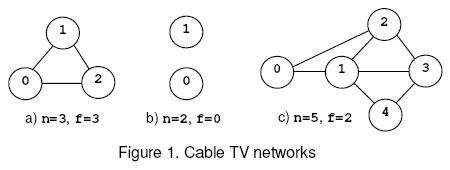poj1966枚舉源匯點求點連通度
阿新 • • 發佈:2017-08-12
+= sets sent line ise order less several dir Cable TV Network
1. n, if the net remains connected regardless the number of relays removed from the net.
2. The minimal number of relays that disconnect the network when removed.

For example, consider the nets from figure 1, where the circles mark the relays and the solid lines correspond to interconnection cables. The network (a) is connected regardless the number of relays that are removed and, according to rule (1), f=n=3. The network (b) is disconnected when 0 relays are removed, hence f=0 by rule (2). The network (c) is disconnected when the relays 1 and 2 or 1 and 3 are removed. The safety factor is 2.
| Time Limit: 1000MS | Memory Limit: 30000K | |
| Total Submissions: 4851 | Accepted: 2239 |
Description
The interconnection of the relays in a cable TV network is bi-directional. The network is connected if there is at least one interconnection path between each pair of relays present in the network. Otherwise the network is disconnected. An empty network or a network with a single relay is considered connected. The safety factor f of a network with n relays is:1. n, if the net remains connected regardless the number of relays removed from the net.
2. The minimal number of relays that disconnect the network when removed.

For example, consider the nets from figure 1, where the circles mark the relays and the solid lines correspond to interconnection cables. The network (a) is connected regardless the number of relays that are removed and, according to rule (1), f=n=3. The network (b) is disconnected when 0 relays are removed, hence f=0 by rule (2). The network (c) is disconnected when the relays 1 and 2 or 1 and 3 are removed. The safety factor is 2.
Input
Output
Sample Input
0 0 1 0 3 3 (0,1) (0,2) (1,2) 2 0 5 7 (0,1) (0,2) (1,3) (1,2) (1,4) (2,3) (3,4)
Sample Output
0 1 3 0 2
參考了網上一份EK的
http://blog.csdn.net/wangjian8006/article/details/7988221
EK的代碼量少很多啊,但是比較慢
#include<queue> #include<cstdio> #include<cstring> #include<algorithm> using namespace std; const int N=110; const int INF=1<<29; int mp[N][N],flow[N][N]; int pa[N]; int bfs(int n,int st,int ed){ int a[N]; memset(a,0,sizeof(a)); memset(pa,-1,sizeof(pa)); queue<int>Q; Q.push(st); a[st]=INF; while(!Q.empty()){ int u=Q.front();Q.pop(); for(int i=0;i<n;++i) { if(!a[i]&&mp[u][i]>flow[u][i]) { Q.push(i); pa[i]=u; a[i]=min(a[u],mp[u][i]-flow[u][i]); if(i==ed) break; } } } return a[ed]; } int EK(int n,int sp,int fp){ int maxflow=0,tmp; memset(flow,0,sizeof(flow)); while(tmp=bfs(n,sp,fp)){ for(int i=fp;i!=sp;i=pa[i]){ flow[i][pa[i]]-=tmp; flow[pa[i]][i]+=tmp; } maxflow+=tmp; } return maxflow; } int main(){ int a,b,n,m; while(scanf("%d%d",&n,&m)!=EOF){ memset(mp,0,sizeof(mp)); for(int i=0;i<n;++i) mp[i][i+n]=1; for(int i=0;i<m;++i) { scanf(" (%d,%d)",&a,&b); mp[a+n][b]=mp[b+n][a]=INF; } int ans=INF; for(int i=0;i<n;++i) for(int j=i+1;j<n;++j) ans=min(ans,EK(2*n,i+n,j)); if(ans==INF) printf("%d\n",n); else printf("%d\n",ans); } }
poj1966枚舉源匯點求點連通度
